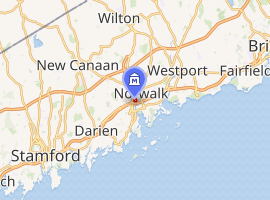Stepping Stones Museum for Children
Stepping Stones Museum for Children is a hands-on children's museum for ages 10 and under located at 303 West Avenue, in the Central section of Norwalk, Connecticut.

| |
| Established | 2000 |
|---|---|
| Location | 303 West Avenue Norwalk, Connecticut, United States |
| Type | Children's museum |
| Website | www.steppingstonesmuseum.org |
The museum's interactive exhibit areas include: "Energy Lab"; a "Multimedia Gallery" with a theater, a state-of-the-art broadcast studio, and an 35-foot (11 m)-by-12-foot (3.7 m)-foot high-definition screen;[1] "Healthyville", with exhibits about bodies and healthy living; "Tot Town", an exploration area just for toddlers; "Family and Teacher Resource Center" where parents, caregivers and teachers have access to the latest and best information and programs about learning through play, early literacy, 21st century learning skills and the developmental needs of young children, helping them to facilitate a child's learning – at home or at school.
The entrance lobby houses ColorCoaster, a 27-foot (8.2 m) kinetic sculpture designed by artist George Rhoads.
The garden features three Kinetic Energy Sculptures designed by Beinfield Architecture, which use local solar, wind and water energy to delight and instruct museum-goers. This colorful set of kinetic sculptures demonstrate simple principles of energy generation while creating percussive music.
In 2011 the museum received LEED Gold Certification. Recognized by the Governor of Connecticut as one of the first projects in the state to achieve LEED Gold status, the design employs a range of solutions, from energy efficiency and use of alternative energy sources, to ensuring healthy indoor air quality to water conservation. The building achieves a unique harmony between the site, the structure and the exhibits. Each element was harnessed to enhance the educational mission of the museum.
The museum is located in Mathews Park, adjacent to the Lockwood-Mathews Mansion, the Center for Contemporary Printmaking, a gallery and studio for printmaking, and Devon's Place, a playground designed for all children to play together, including those with physical, sensory and mental challenges.
History
Stepping Stones was founded in 2000 by Gigi Priebe.[2] In its first 10 years of operation, the museum received two million [1] visits.
The museum underwent a $17 million renovation in 2010, which closed Stepping Stones from August 17 to late November (with a "grand reopening" on November 20) and resulted in a 22,000-square-foot (2,000 m2) expansion, roughly doubling the indoor space of the facility. The project, designed by Beinfield Architecture, enhanced the Museum with a naturally energy-efficient work environment, recycled and locally sourced materials, a forty-foot screen multi-media theatre and communication facility, an interior telescope for viewing rooftop plant and animal life, and three garden “follies” utilizing solar, wind and water energy.
The Museum received LEED Gold status in 2011, as well as Green Advocate and Merit awards from The Connecticut Green Building Council, citing the project team's “commitment to sustainability from the outset, an attitude that clearly impacted every decision, from design through construction and beyond. The unique function of the institution as a children's museum also offers the opportunity to educate and energize young minds about these goals both during construction and on a daily functioning basis.
The building achieves a unique harmony between the site, the structure and the exhibits. Each element was harnessed to enhance the educational mission of the museum.”
Notes
The renovation resulted in improvements to the Tot Town and Healthyville exhibits;[3]
The "Energy Lab" exhibit replaced the "Water Scape" exhibit; the "Rainforest Adventure" exhibit formerly a permanent installation will be housed in a wing for traveling exhibits .[3]
See also

References
- Hennessy, Christina, "Renovated Stepping Stones Museum for Children in Norwalk is bigger, better", November 18, 2010, Connecticut Post and Danbury Times and Stamford Advocate, retrieved from the Connecticut Post website on November 21, 2010
- Web page titled "About Us" at the Stepping Stones Museum for Children website, retrieved November 21, 2010
- Kobak, Steve, "Children's Museum reopens to public", pp 1, A6, The Sunday Hour, November 21, 2010